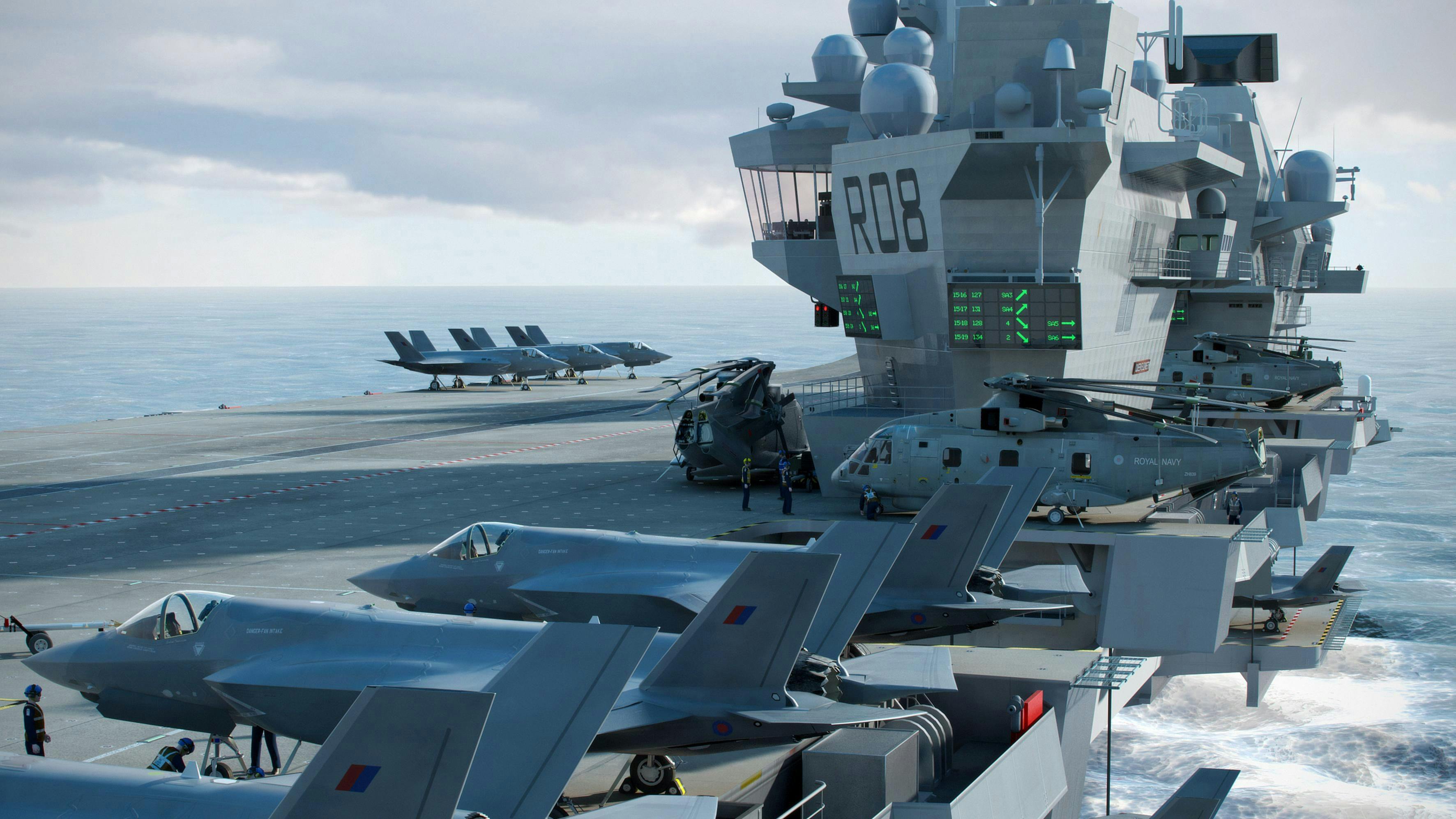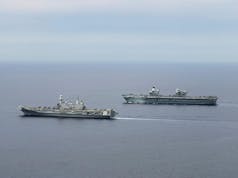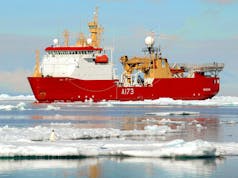Plans for frequent deployment of American F-35 aircraft alongside British jets aboard HMS Queen Elizabeth have been confirmed by Defence Secretary Michael Fallon.
Defence Secretary Michael Fallon confirmed that the US will deploy F-35B aircraft on board the Royal Navy’s new aircraft carrier HMS Queen Elizabeth when it comes into service, with British jets expected to do the same on US vessels when required “in the fullness of time”.
The Ministry of Defence have clarified the details surrounding the Queen Elizabeth class aircraft carriers and their complement of F-35 aircraft, no doubt in response to the plethora of claims that the vessels will sail with “no aircraft”, “no crew”, no sandwiches in the galley etc.
- It was always the intention to take a phased approach to ordering F-35.
- The UK is committed to both the F-35 and the Queen Elizabeth Carrier programmes, both of which are on track to enter initial maritime operating capability in December 2020 as planned.
- Queen Elizabeth commenced sea trials in 2017, and UK F-35 aircraft will be used for first of class flying trials in 2018.
- US aircraft will augment British jets on coalition operations, not replace them and they will not fly from the vessel first.
Tabloids often like to quote 12 as the maximum number of F-35Bs the carrier will be able to carry (despite the intention to purchase 138 in the long term), however this, as you probably know, is nonsense.
What will the vessels carry?
The term now used for the carriers embarked squadrons is ‘Carrier Air Wing’ (CVW). The vessels are capable of deploying a variety of aircraft in large numbers, up to a maximum in the upper fifties in surge conditions.

Captain Jerry Kyd, commander of HMS Queen Elizabeth, commented on the initial deployment and the gradual increase in air wing numbers:
“We are constrained by the F-35 buy rate even though that was accelerated in SDSR in 2015, so initial operating capability numbers in 2020 are going to be very modest indeed.
We will flesh it out with helicopters, and a lot depends on how many USMC F-35s come on our first deployment in 2021. But by 2023, we are committed to 24 UK jets onboard, and after that it’s too far away to say.”
In addition to the joint force of Royal Air Force and Royal Navy F-35Bs and their pilots, the air wing is expected to be composed of a ‘Maritime Force Protection’ package of nine anti-submarine Merlin HM2 and four or five Merlin for airborne early warning; alternatively a ‘Littoral Manoeuvre’ package could include a mix of RAF Chinooks, Army Apaches, Merlin HC4 and Wildcat HM2. We understand that vessel would still carry at least one F-35 squadron aboard in such circumstances to offer air defence as well as support to the helicopter assault activities.
The Crowsnest AEW&C aircraft will come from a number of the embarked Merlins (any of which can be fitted with the sensor package), the number again scaling with requirements.
Around the time the first carrier deploys operationally, the UK will have 42 F-35 aircraft, with 24 being front-line fighters and the remaining 18 will be used for training (at least 5 on the OCU), be in reserve or in maintenance.
Recently, the Ministry of Defence confirmed plans for the deployment of American F-35 aircraft alongside British jets aboard HMS Queen Elizabeth.
The addition of US Marine Corps aircraft will see HMS Queen Elizabeth sail with 24 or so F-35Bs in addition to around 14 or so helicopters for her maiden deployment. It is understood that the US aircraft will augment British jets on coalition operations.
We discussed claims that the vessel will not have enough jets assigned to her with retired Air Marshal Greg Bagwell who said:
“There is absolutely no need to fix a flexible capability so far in advance – it hems politicians in unnecessarily.”
Another source we spoke to, currently flying the jet, explained to us that the vessels will deploy with the number and type of aircraft required for a specific deployments:
“Where F-35B is based is entirely down to the most suitable basing option for the tasks/missions is being sent to do. If that’s a well-founded host nation base, great; if it’s the Carrier, great; if it’s an austere location, fine.
Range, logistics and other ‘enablers’ such as AAR and connectivity will determine what’s the best option.”
The Queen Elizabeth class mark a change from expressing carrier power in terms of number of aircraft carried, to the number of sortie’s that can be generated from the deck. The class are not the largest class of carrier in the world but they are most likely the smallest and least expensive carrier the Royal Navy could build which still have the advantages that large carriers offer.













So much for being ‘4 acres of sovereign UK territory ‘. This just another way found by the government to wiggle their way out of properly funding defense!!
Didn’t read the article, did you David?
This makes sense, the USMC harriers used to operate on a semi-regular basis from the old Invincible class ships.
As the UK builds up it’s 5 F35B squadrons there is no reason why UK aircraft shouldn’t fly of USMC assault ships as well.
We need to work up procedures for operating carriers with full flight decks. At his is a great way to do it, plus we can learn a lot from the USA; they’ve been doing this for a while without the big capability gaps that we’ve had. Seems like good news to me.
I’m so disappointed in how we messed up these carriers. They have so little compatibility with other nations (no catapult or arrester gear), larger payload aircraft can’t be launched from them, the ramp is an old technology and if the Americans can operate EM or hydraulic catapults on 10 carriers, launching F-35B’s with them too, then surely we could’ve done the same with 2. I can’t tell whether the decision to go for less capable ships was out of cost or old politicians/military brass who liked the way the old invincible class looked.
They have compatibility with USS America, Wasp Class, Italian Navy’s Cavour (plus the Trieste when it is completed) and maybe the Juan Carlos (even Spain can ever afford F35Bs).
Its slightly less capable for an enormously lower cost.
These are excellent ships, You really do not have a clue what you are talking about!
If you spend £3.2bn on a ship then you really need to ensure it is fully loaded. It is ridiculous to believe that you have a strike capability unless it really is.
I am afraid this smacks of “fur coat – no knicker” pointless exercise and a waste of money. Send it out full of capability or not at all.
Pathetic…..
Even the US don’t have their carriers at full load very often. I doubt we will ever see our carriers with their full 48 (or whever the figure was) jets, but hopefully we will see them with more than the most likely 12.
I’m not really sure what you’re talking about Pacman – we’re buying 150 F35’s so of course we can fully load the carriers – what’s your point?
138 Mark….. in the planes lifespan. which is up to 2070!
And those 138 are to replace your harrier & Tornado fleets.
There will never be more than 70 in existence at any time.
It’s a massive force structure reduction.
“If you spend £3.2bn on a ship then you really need to ensure it is fully loaded.”
I just don’t follow that logic.
Should Bulwark or Albion always set sail with a complement of 710 marines and full load of support vehicles embarked? Should a Bay class always deploy similarly fully loaded with troops & equipment? The important thing is the capacity that is available if required.
Admittedly there are two concerns I can see about UK carrier capacity, one is timing but that is only timing, we will get there. The other is that the carriers can’t really operate the maximum number of aircraft claimed for the design without working up the procedures and getting personal trained and familiar with operating at full load. The prospect of having extra USMC F-35B embarked early on, before the UK get’s sufficient numbers of its own F35B, very directly addresses that second problem.
And once again George tells his self perpetuating falsehood that the tabloids claim the carriers can only accommodate 12 aircraft.
PROVE IT GEORGE!
I’ve read many tabloid articles that quite rightly ask the question, why have such big 50+ aircraft capacity carriers when they’ll only routinely carry 12? It’s a darn good question that the MoD can only answer with “we’re too cheap to buy enough aircraft to defend the UK so we’ll give the Americans a free ride with theirs in order to promote American interests”.
Meanwhile the US president says the UK must go to the back of the queue for trade deals.
Brilliant.
You really do not have a clue what these ships are all about and what they are designed and built to do. They are not designed and built to just be strike carriers, they are built and designed to be extremely flexible and versatile multi purpose platforms that can perform various roles as future circumstances determine and require. These roles include, among others, that of a large front line strike carrier with F35B’s, a helicopter assault ship with chinook / apache helicopters and a large contingent of marines, a disaster relief or hospital ship, a major ASW asset with large numbers of ASW helicopters, etc. etc. or any combinations of these or other roles. Consequently the number of F35B’s carried will be tailored and range from zero to 40+ depending on what the mission roles require. These multifunctional ships have the ability to become world renown examples of naval excellence as their forbears, the WW1 Queen Elizabeth class battleships , did in their time.
“Meanwhile the US president says the UK must go to the back of the queue for trade deals.”
Just like where the EU is!